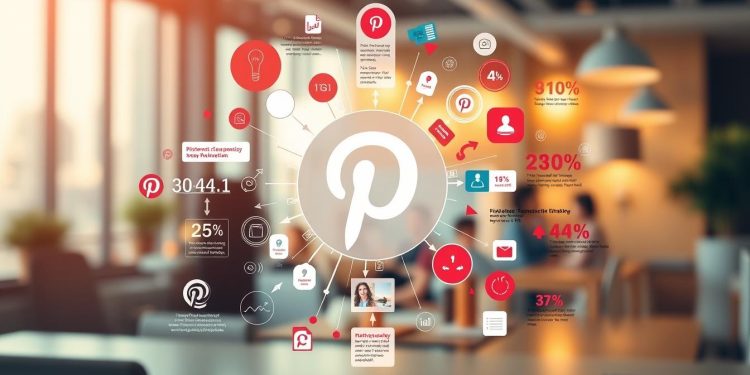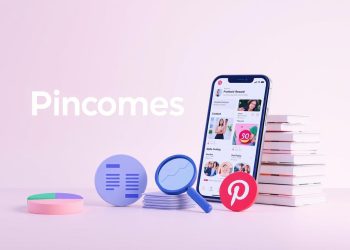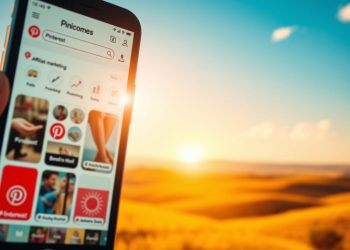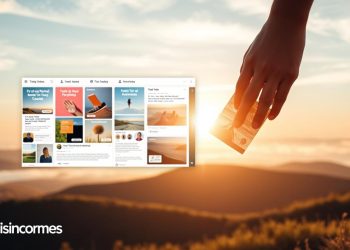Did you know 85% of weekly Pinterest users have purchased products they discovered through Pins? This visual-first platform now drives more than 460 million monthly users to explore ideas, plan purchases, and connect with brands – turning casual browsing into concrete sales.
What began as a digital scrapbook for DIY enthusiasts has transformed into a marketing powerhouse. The platform combines search engine functionality with social sharing, helping businesses reach audiences actively seeking inspiration. With conversion rates outperforming many traditional channels, smart brands are rethinking their social media strategies.
This guide reveals how to leverage Pinterest’s unique blend of visual discovery and commercial intent. You’ll learn to create content that converts browsers into buyers while building lasting brand loyalty. Let’s explore actionable tactics to unlock explosive growth through this underutilized channel.
Key Takeaways
- 85% of weekly users make purchases inspired by Pins
- 460 million active users seek products through visual search
- Combines search engine functionality with social sharing
- Delivers higher conversion rates than many platforms
- Essential for modern social media strategies
- Focuses on commercial intent and product discovery
Understanding the Power of Pinterest in Modern Marketing
What drives 83% of users to plan purchases before they even search on Google? The answer lies in visual discovery platforms that blend inspiration with intent. Unlike traditional social networks, this space thrives on purposeful browsing—where scrolling becomes shopping research.
From DIY Inspiration to a Marketing Powerhouse
Originally a hub for craft ideas and recipe collections, the platform now fuels $1.6 billion in annual retail sales. Users arrive with commercial intent, actively searching for products through features like Lens visual search. Over 61% discover new brands weekly while curating boards for home decor, fashion, or business tools.
Key Trends and User Behavior Insights
People use this channel differently than Instagram or TikTok. Instead of chasing trends, they’re:
- Planning major purchases 30% earlier than other platforms
- Saving pins to private boards for later comparison
- Sharing curated collections with decision-making groups
High-quality pins drive 3.4x more engagement than generic posts. Why? 77% prioritize visual appeal when evaluating products. Brands that showcase lifestyle content with clear calls-to-action see 42% higher click-through rates. This shift turns casual browsing into measurable sales pipelines.
The Benefits of Pinterest Marketing for Business Growth
Four out of five weekly users uncover fresh brands while browsing—a goldmine for businesses ready to stand out. Take Crumbl Cookies, which exploded to 250,000 followers in six months by showcasing mouthwatering dessert videos. Their secret? Tapping into users’ desire to discover products before they actively search for them.

Boosting Brand Awareness and Engagement
Interactive content drives 3x more saves than static posts. Recipe tutorials with step-by-step pins or behind-the-scenes product stories create lasting connections. Curated boards mimicking customers’ aspirations—like “Weekend Baking Projects” for kitchenware brands—keep audiences returning.
One jewelry designer increased conversions by 60% using Idea Pins demonstrating styling techniques. These visual narratives build trust while subtly guiding viewers toward purchases.
Driving Targeted Traffic to Your Website
Strategic keyword placement turns pins into search magnets. Tools like growth strategies help identify high-traffic phrases like “easy dinner ideas” or “affordable office decor.” Pair these with shoppable links for seamless transitions from inspiration to checkout.
Seasonal campaigns deliver 40% higher click-through rates when timed with planning cycles. A gardening brand doubled website visits by publishing spring planting guides in January—right when users start plotting their gardens.
Building a Compelling Pinterest Profile
Your profile acts as a digital storefront—hook browsers in seconds or lose them forever. Top-performing accounts mirror their website’s visual identity while showcasing what makes their brand unique. Start with crisp profile photos (165×165 pixels) that maintain clarity across devices.

Branding Your Profile and Selecting the Right Visuals
Seasonal cover images work like magic. Brands like Anthropologie rotate designs monthly to match shopping trends—think cozy textures for fall or bright florals for spring. Consistent color schemes and fonts boost recognition by 47% compared to mismatched profiles.
Verify your website immediately. This unlocks analytics showing which pins drive traffic and conversions. Rich Pins—auto-updating product listings—become available, turning casual viewers into shoppers.
Crafting a Keyword-Rich Bio
Treat your bio as a 160-character elevator pitch. Include search-friendly terms like “handcrafted jewelry” or “organic skincare” instead of generic phrases. Tools like Keyword Tool Dominator reveal what your audience seeks.
Organize boards like curated store sections. Use descriptive names (“Outdoor Entertaining Ideas”) and cohesive covers. A home decor brand increased saves by 33% using numbered board titles like “5-Minute Table Settings.”
Remember: Your profile isn’t just a placeholder—it’s a conversion engine. Blend visual appeal with strategic keywords, and watch curious scrollers transform into loyal customers.
Pinterest in Marketing: Optimized Strategies for Your Business
Visual discovery platforms now fuel over 40% of purchase decisions before shoppers visit stores. To dominate this space, you need a battle-tested blueprint blending creativity with conversion science.

Developing a Customized Marketing Plan
Start by mapping your goals to platform capabilities. Successful strategies follow six core steps:
- Audit existing content for keyword gaps and visual appeal
- Design product-focused boards mirroring customer aspirations
- Schedule weekly rich media posts (video demos, carousels)
- Engage with trending topics through comment collaborations
- Analyze metrics to double down on high-performing formats
- Reinvest top-performing content into paid campaigns
Home decor brand Urban Outfitters saw 58% more saves using this approach. Their secret? Product pins with styling tips that users could instantly shop.
Integrating Organic and Paid Growth Tactics
Organic efforts build trust through authentic storytelling. Share behind-the-scenes reels showing your brand’s craftsmanship. Host Q&A Idea Pins answering common product questions.
Paid promotions amplify reach during key seasons. Consider these comparisons:
| Tactic | Organic | Paid |
|---|---|---|
| Reach | Steady growth | Immediate spikes |
| Cost | Time investment | Budget allocation |
| Best For | Community building | Product launches |
Blend both approaches for maximum impact. One skincare company achieved 30% higher conversion rates using organic tutorials alongside carousel ads showcasing products in real-life routines.
Ready to transform browsers into buyers? Your visual playbook starts now.
Optimizing Your Pinterest Presence with SEO
Search optimization transforms casual browsers into loyal customers on visual platforms. While most brands focus on aesthetics alone, SEO-driven content drives 3x more organic traffic over time. Let’s break down how to make your pins irresistible to both users and algorithms.

Conducting Keyword Research and Incorporating Trends
Start by exploring the platform’s search bar. Type your niche phrase like “eco-friendly home decor” and note the auto-suggestions. These reveal what real users are hunting for right now.
Follow this 4-step process:
- Use the Trends tool to spot rising phrases (e.g., “minimalist desk setups”)
- Filter results by your target country and time frame
- Compare monthly searches against competition levels
- Test combinations like “budget-friendly [keyword] ideas”
One kitchenware brand boosted traffic by 40% targeting “5-minute meal prep” during lunchtime peaks. Track seasonal shifts—users search “holiday gift guides” 3 months earlier than Google.
Optimizing Pin Titles and Descriptions
Front-load your primary keyword in titles. Keep them under 60 characters for full mobile visibility. Compare these examples:
| Weak Title | Strong Title |
|---|---|
| Beautiful Living Room | Mid-Century Modern Sofa Ideas 2024 |
Descriptions should weave keywords naturally. Use action verbs like “discover” or “transform” while answering “What’s in it for me?” A plant shop increased saves by 25% adding phrases like “low-light succulents for busy lifestyles.”
Pair text with crisp, vertical images (2:3 ratio). Update old pins with fresh keywords—this takes minimal time but extends content lifespan. Remember: SEO isn’t a one-time task. Audit your top performers monthly to ride new trends.
Leveraging Different Pin Formats and Rich Media
Visual storytelling takes center stage in modern digital strategies. The platform offers three powerhouse formats—each serving unique purposes in your content engine. Master these tools to turn casual viewers into engaged followers.
Using Image Pins, Video Pins, and Idea Pins Effectively
Image pins remain the workhorse for product showcases. Use crisp vertical layouts (1000×1500 pixels) with text overlays highlighting key features. A jewelry brand increased saves by 40% using lifestyle shots showing accessories in real-world settings.
Video pins drive 3x more engagement than static posts. Create 15-second demos showing products in action—think makeup tutorials or quick recipe videos. Blend educational value with subtle calls-to-action.
Idea pins unlock deeper storytelling. These multi-page formats let you share step-by-step guides or behind-the-scenes processes. One home decor company used them to demonstrate furniture assembly hacks, boosting website traffic by 28%.
Repurpose content across formats effortlessly:
- Transform blog posts into carousel image pins
- Convert customer testimonials into video case studies
- Break down infographics into Idea Pin sequences
Maintain brand consistency using color-coded templates. Track analytics to identify top-performing formats. Rotate content types weekly—mix educational videos with inspirational mood boards to keep feeds dynamic.
Successful strategies balance experimentation with cohesion. A skincare brand achieved 33% higher engagement using matching filters across all pins while testing new ideas monthly. Your visual content should feel familiar yet fresh—like a favorite magazine that always delivers surprises.
Scheduling and Publishing Strategies for Maximum Engagement
Consistent visibility separates thriving accounts from forgotten ones. Tools like Sprout Social reveal that brands posting 15-30 pins weekly see 3x more saves than sporadic uploaders. The key lies in strategic timing—publish when your audience scrolls actively, not when you remember to post.
Smart Automation for Steady Growth
Pin scheduling tools transform chaotic workflows into streamlined systems. Analyze your account analytics to spot peak engagement windows—weekday mornings often outperform weekends for B2C brands. Create a rotating content mix:
- 40% product-focused pins
- 30% educational content
- 20% user-generated inspiration
- 10% promotional offers
This way of balancing ensures fresh ideas without overwhelming followers. Tools like Tailwind’s SmartSchedule automatically push pins during high-traffic hours. One home decor brand boosted click-through rates by 22% aligning posts with evening browsing habits.
| Tool | Best Feature | Ideal For |
|---|---|---|
| Sprout Social | Cross-platform analytics | Multi-channel teams |
| Tailwind | Drag-and-drop calendar | Visual planners |
| Later | Bulk uploading | High-volume accounts |
Build a description-driven content calendar mapping pins to campaigns. Color-code categories for quick edits—red for holidays, blue for tutorials. This way of organizing lets you adapt trends while maintaining brand voice. Remember: One optimized pin per day outperforms five rushed posts.
Driving Traffic and Boosting Sales through Strategic Pinterest Ads
Visual platforms now deliver 2.3x better conversion efficiency than traditional channels—here’s how to claim your share. Brands leveraging strategic ad campaigns see 48% higher click-through rates compared to organic posts alone. This gap isn’t luck; it’s science.
Understanding the ROI of Pinterest Advertising
Data reveals campaigns here convert browsers 30% faster than other platforms. Why? Users actively search for products rather than passively scroll. Compare performance metrics:
| Platform | Cost Per Conversion | Engagement Rate |
|---|---|---|
| Traditional Social | $12.50 | 1.8% |
| Visual Discovery | $5.40 | 4.2% |
Follow this blueprint to maximize returns:
- Define clear objectives (sales vs. awareness)
- Target users based on recent search behavior
- Test multiple creative formats weekly
- Analyze Pinterest analytics to refine bids
Setting Up Shoppable Pins and Catalog Ads
Transform inspiration into instant purchases with shoppable tags. Ecommerce brands using these tools report 63% faster checkout cycles. Key advantages:
- Auto-updated product availability
- Price comparisons across retailers
- Direct “Shop Now” buttons on trending pins
Catalog ads take this further by showcasing your entire inventory. Sync your product feed using platforms like this step-by-step playbook. One fashion retailer boosted holiday sales by 210% featuring matching accessories beneath dress pins.
Pro tip: Blend carousel ads with video tutorials. Users who watch demo clips convert 2.8x more often. Start small—test three ad types monthly—then scale what works. Your perfect marketing strategy awaits discovery.
Utilizing Analytics and Trends to Refine Your Strategy
Data transforms guesses into growth—here’s how to decode what works. Platforms offering visual discovery thrive on real-time insights, letting you pivot faster than traditional social channels. Nearly 68% of top-performing brands adjust their strategies weekly based on metrics.
Monitoring Engagement and Conversion Metrics
Track three core metrics to gauge success:
- Saves: Indicates content value and future purchase intent
- Outbound clicks: Measures traffic-driving effectiveness
- Conversion rate: Reveals how pins translate to sales
Tools like Pinterest Analytics highlight top-performing pins. Compare these metrics across content types:
| Content Type | Avg. Save Rate | Click-Through |
|---|---|---|
| Product Pins | 12% | 8.4% |
| Video Tutorials | 18% | 6.1% |
| Idea Pins | 22% | 4.9% |
Shift resources to formats driving your goals. A skincare brand doubled conversions by reallocating 40% of its budget to high-save video pins.
Leveraging Trends for Seasonal Campaigns
Use the Trends dashboard to spot emerging interests. Searches for “sustainable holiday decor” spike 90 days before December. Plan campaigns early to capture planners.
Repurpose a blog post into seasonal pins when trends align. One outdoor brand increased winter gear sales by 75% using summer hiking guides tagged with “cold-weather prep.”
Unlike traditional social platforms, trends here reflect long-term planning. Sync your calendar with these cycles to stay ahead. Check the dashboard weekly—what’s rising today could fuel next quarter’s wins.
Conclusion
Visual discovery platforms have revolutionized how brands connect with ready-to-buy audiences. Through strategic SEO-optimized content and data-driven planning, businesses can drive traffic faster than traditional methods allow. Success stories prove it—from 60% conversion jumps to 210% holiday sales spikes.
Your action plan starts now. Audit boards for relevant keywords and refresh older pins. Blend video demos with shoppable posts to meet users at every discovery stage. Track saves and clicks weekly—these metrics reveal what converts browsers into buyers.
Remember: top performers test constantly. Rotate pin formats monthly and refine descriptions using trending phrases. Well-organized boards act as 24/7 sales tools when paired with crisp visuals and clear CTAs.
Ready to transform inspiration into revenue? Launch three new pins today. Optimize one board with fresh keywords. The path to explosive growth begins with your next upload.
FAQ
How does Pinterest differ from other social platforms for business growth?
Unlike traditional social networks, Pinterest functions as a visual search engine where users actively seek inspiration and products. Its evergreen content lifespan and shoppable features make it ideal for driving sustained traffic and sales.
What types of content perform best for driving website clicks?
High-quality vertical images (2:3 ratio), video pins demonstrating products in use, and Idea Pins with step-by-step tutorials generate strong engagement. Include clear CTAs like “Shop Now” and link directly to product pages.
How often should businesses post on Pinterest?
Brands see optimal results with 15-30 pins daily across multiple boards. Use scheduling tools like Tailwind to maintain consistency without manual effort. Prioritize quality over quantity – repurpose top-performing content with fresh visuals.
Can Pinterest ads compete with Meta’s advertising platforms?
Promoted pins often deliver 2.3x higher ROI than social ads for e-commerce brands, according to Pinterest’s 2023 data. The platform’s lower ad saturation and high purchase intent from users make it cost-effective for reaching niche audiences.
What SEO tactics boost pin visibility?
Conduct keyword research using Pinterest’s search bar autocomplete and Trends tool. Optimize pin titles with primary keywords (under 60 characters), add detailed descriptions using secondary keywords, and enable Rich Pins to auto-pull product data from your website.
How do shoppable pins work for e-commerce brands?
Connect your product catalog through Pinterest Shopping to create dynamic pins with real-time pricing/availability. Users can checkout directly via platforms like Shopify integration, reducing purchase friction by 40% compared to standard links.
What metrics matter most in Pinterest Analytics?
Track monthly viewers, outbound clicks, and conversion rates. Use the “Converted Audience” report to identify high-value customer segments, then create lookalike campaigns to scale profitable traffic.
Are group boards still effective for reach expansion?
While less critical since algorithm updates, curated group boards with active users in your niche can amplify content. Prioritize boards requiring manual approval to maintain quality – avoid spammy “follow-for-follow” communities.











